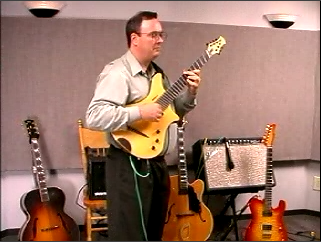Caution: The following post is nerdy and technical and stuff. If the term “music theory” makes your knees wobble and your teeth chatter, turn back!
If you’re still here, I’d like to talk about modes. Lots of people seem to struggle with them, and I’ve never understood why. Even my own musician friends, when prompted to discuss modes, look around nervously and shudder. “Modes?” they whisper. “Shh, we don’t mention those.”

Guys, I promise you, modes are not complicated! I can only assume their reputation is due to misconceptions and poor teaching. Thus, I’ll try a simplified explanation—but before I do, let’s dispel a couple of the bigger myths.
Myth 1: Modes are advanced musical concepts that only apply to jazz, fusion, and progressive rock.

Actually, this isn’t true at all. Modes are some of the most fundamental concepts in theory, and they apply to every piece of music in existence. Ever played in a minor key? It’s a mode! What about a major key? Guess what—it’s a mode too.
Myth 2: Modes are a set of exotic scales that you need to sit down and memorize.
Wrong! All seven of the common modes (ionian, dorian, phrygian, lydian, mixolydian, aeolian, and locrian) are based on the major scale. If you know how to play or sing a major scale, you already know how to play or sing all of the modes.
If you have a hard time understanding modes, try this analogy.
Imagine a family of seven people sitting at a dinner table: two parents and five children. The father of the family is the dominant figure. He speaks the most often and draws the most attention. He’s happy to let the others talk, but most conversations start and end with his input. His voice is regular, strong, and familiar. His name is Ionian, but you might know him by his nickname: Major.

His lovely wife is also pretty talkative, but she has a different tone of voice. When she leads the conversation, everyone seems to think her topics sound darker and gloomier (though she’d scoff and disagree). Her name is Aeolian, but she usually goes by Minor.
Now, once in a while, one of the children will have something to say. Some evenings, over dinner, one of them will be the dominant voice. It feels a little weird when that happens. You can tell something’s off, or abnormal. But when a child has a really interesting topic to discuss, it can go very well, and give a whole new perspective that wouldn’t have been heard otherwise.

You probably know all of the kids already. Phrygian is really popular in school, and she’s got a beautiful voice that’s somewhat similar to her mother’s. Lydian is sometimes called a hipster, and he’s definitely edgy—but he has many friends, and some say he’s the coolest dude they’ve ever met. Poor Locrian is socially awkward, but his parents love him anyway. I think you’ve also met Dorian, who takes after her mother, and Mixolydian, who’s more like his father. Together, these seven are a wonderful and happy family.

The family members are the seven notes of a major scale. Strictly speaking, I should’ve referred to them by their scale degrees (tonic, supertonic, etc.), but those words are intimidating. For simplicity, I just named them after their corresponding modes.
Since it’s a major-scale family, Mr. Major (aka Mr. Ionian, or the root note) usually leads the conversation, giving a strong and familiar sound. Most of your musical phrases will start and end with him, and will be centered around his voice. If this is the case, chances are you’re in a major key—the ionian mode. But it’s also common that the sixth note leads the conversation. When this happens, you get Ms. Minor’s key, or the aeolian mode.
The rest of the family follows the exact same pattern. Dorian is based on the second note, Phrygian on the third, Lydian on the fourth, and Mixolydian on the fifth. The universally hated Locrian is seventh. Remember, music is always in a mode! To find out which one, you just need to determine which member of the family is being emphasized, or tonicized.

Musicians, theory experts, please leave your feedback! I’d love to know what you think, and whether you have another way to explain modal context.